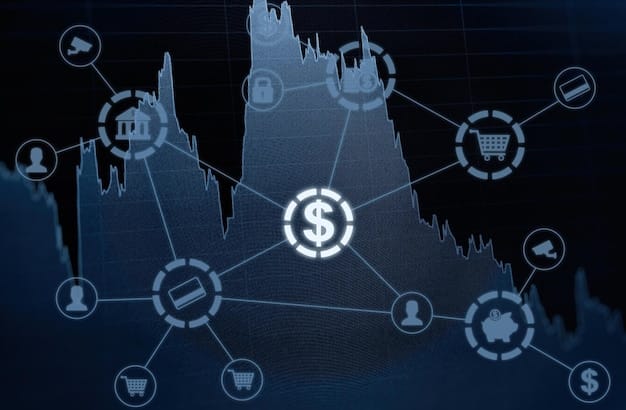Blockchain Scalability Solutions: A 2025 US Market Comparison

Blockchain scalability solutions, particularly layer-2 protocols, are poised for significant advancements in the US market by 2025, offering faster transaction speeds and lower costs compared to the main blockchain.
Addressing the challenges of transaction speed and cost, blockchain scalability solutions are rapidly evolving. This article compares key layer-2 protocols anticipated to make waves in the US market by 2025.
Understanding Blockchain Scalability Challenges
Blockchain technology, while revolutionary, faces inherent scalability challenges. As networks grow, transaction speeds slow down, and costs increase, hindering widespread adoption. Understanding these limitations is crucial to appreciating the need for scalability solutions.
The Blockchain Trilemma
The blockchain trilemma proposes that a blockchain can only achieve two of the following three properties: decentralization, security, and scalability. Achieving all three simultaneously remains a significant challenge.
The Impact of Slow Transaction Speeds
Slow transaction speeds, measured in transactions per second (TPS), can frustrate users and limit the types of applications that can be built on a blockchain. For example, Bitcoin’s TPS is relatively low compared to traditional payment systems.
- Network Congestion: High demand can lead to network congestion, further slowing down transaction processing.
- User Experience: Lengthy confirmation times can degrade the user experience, especially for real-time applications.
- Scalability Bottlenecks: The inherent architecture of some blockchains creates bottlenecks that limit scalability.
Addressing these challenges is essential for blockchain technology to reach its full potential. Scalability solutions aim to overcome these limitations without compromising security or decentralization.
Layer-2 Protocols: An Overview
Layer-2 protocols offer a promising approach to scaling blockchains by processing transactions off-chain while still leveraging the security of the main chain. These solutions are built on top of existing blockchains, enhancing their capabilities without altering their core structure.
How Layer-2 Protocols Work
Layer-2 protocols operate by moving a portion of the transaction processing off the main blockchain. This reduces the load on the main chain, allowing for faster and cheaper transactions.
Types of Layer-2 Protocols
There are several types of Layer-2 protocols, each with its own unique approach to scaling blockchains.
- State Channels: Enable direct interaction between participants off-chain, with only opening and closing states recorded on the main chain.
- Sidechains: Independent blockchains that run parallel to the main chain, connected by a two-way bridge.
- Rollups: Aggregate multiple transactions into a single batch, which is then submitted to the main chain.
Layer-2 protocols represent a diverse and evolving landscape of solutions designed to address the scalability challenges of blockchain technology.
State Channels: Lightning Network and Beyond
State channels provide a direct communication pathway between two or more participants, allowing them to conduct multiple transactions off-chain. Only the initial opening and final closing states are recorded on the main blockchain.
Lightning Network for Bitcoin
The Lightning Network is a prominent example of a state channel implementation, designed to enable faster and cheaper Bitcoin transactions. It allows users to create payment channels and transact instantly.
Use Cases and Limitations of State Channels
State channels are well-suited for applications involving frequent interactions between known parties, such as micropayments and gaming. However, they have limitations in terms of network connectivity and capital efficiency.

- Scalability: Significantly increases transaction throughput compared to the main chain.
- Privacy: Transactions within the channel are not publicly recorded on the blockchain.
- Complexity: Requires participants to be online and maintain channel balances.
State channels offer a valuable approach to scaling blockchains, particularly for specific use cases where frequent interactions between parties are common.
Sidechains: Scaling with Independent Blockchains
Sidechains are independent blockchains that run parallel to the main chain, connected by a two-way bridge. They offer greater flexibility and customization compared to state channels, allowing for different consensus mechanisms and virtual machines.
How Sidechains Enhance Scalability
By processing transactions on a separate blockchain, sidechains reduce the load on the main chain and can offer faster transaction speeds and lower costs. They also allow for experimentation with new features and functionalities without affecting the main chain.
Examples of Sidechains
Several sidechains have been developed to address specific scalability needs. Some prominent examples include:
- Liquid Network: A Bitcoin sidechain focused on enabling faster and more confidential transactions for traders and exchanges.
- RSK: A Bitcoin sidechain that adds smart contract functionality, allowing for the development of decentralized applications.
- Polygon: A Layer-2 scaling solution for Ethereum that uses a network of sidechains to provide faster and cheaper transactions.
Sidechains offer a versatile approach to scaling blockchains, providing a flexible platform for innovation and experimentation.
Rollups: Aggregating Transactions for Efficiency
Rollups are a Layer-2 scaling solution that aggregates multiple transactions into a single batch, which is then submitted to the main chain. This reduces the amount of data that needs to be processed on the main chain, leading to increased transaction throughput and lower costs.
Types of Rollups: Optimistic and ZK
There are two main types of rollups: optimistic rollups and Zero-Knowledge (ZK) rollups. Optimistic rollups assume that transactions are valid unless proven otherwise, while ZK-rollups use cryptographic proofs to verify the validity of transactions.
Advantages and Disadvantages of Rollups
Rollups offer significant scalability improvements compared to the main chain, but they also have some drawbacks to consider.

- Scalability: Can significantly increase transaction throughput, potentially by orders of magnitude.
- Security: Leverages the security of the main chain by submitting transaction data and proofs to it.
- Complexity: Requires sophisticated cryptographic techniques and can be challenging to implement.
Rollups represent a cutting-edge approach to scaling blockchains, offering a balance between scalability and security.
Outlook for 2025: US Market Adoption
By 2025, the US market is expected to see increased adoption of Layer-2 protocols across various blockchain applications. This will be driven by the need for faster transaction speeds, lower costs, and improved user experience.
Factors Driving Adoption
Several factors will contribute to the adoption of Layer-2 protocols in the US market.
- Regulatory Clarity: Clear regulatory guidelines will foster innovation and investment in blockchain technology.
- Technological Advancements: Ongoing advancements in Layer-2 protocols will make them more efficient and user-friendly.
- Growing Demand: Increasing demand for blockchain applications will drive the need for scalability solutions.
Potential Use Cases in the US Market
Layer-2 protocols have the potential to transform various industries in the US market.
- Decentralized Finance (DeFi): Enabling faster and cheaper trading and lending.
- Gaming: Facilitating in-game transactions and asset ownership.
- Supply Chain Management: Improving transparency and efficiency in tracking goods.
These factors will shape the landscape of blockchain scalability solutions in the US market by 2025.
| Key Point | Brief Description |
|---|---|
| ⚡️ Layer-2 Solutions | Off-chain solutions enhancing blockchain scalability. |
| ⛓️ State Channels | Direct off-chain interaction between participants. |
| 🔗 Sidechains | Independent blockchains linked to the main chain. |
| 🔄 Rollups | Aggregate multiple transactions into a single batch. |
Frequently Asked Questions
Blockchain scalability solutions are technologies designed to increase the transaction processing capacity of blockchain networks, addressing issues like slow speeds and high costs.
Layer-2 protocols are solutions built on top of existing blockchains to enhance their scalability. They handle transactions off-chain, reducing the load on the main blockchain.
State channels enable direct interaction between participants off-chain, with only the opening and closing states recorded on the main blockchain, allowing for faster transactions.
Sidechains offer greater flexibility and customization compared to state channels, allowing for different consensus mechanisms and virtual machines, enhancing scalability.
Optimistic rollups assume that transactions are valid unless proven otherwise, providing a scalable solution by batching multiple transactions and submitting them to the main chain.
Conclusion
As we look towards 2025, the landscape of blockchain scalability in the US market is set to be shaped by the increasing adoption of layer-2 protocols. These solutions, including state channels, sidechains, and rollups, promise faster transaction speeds, reduced costs, and enhanced user experiences, paving the way for broader application and integration of blockchain technology across various industries.





